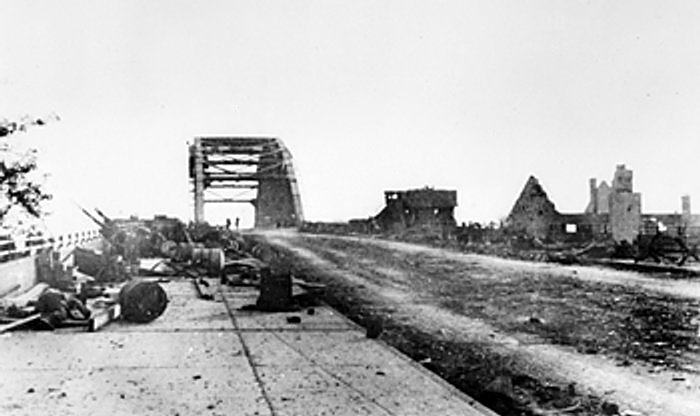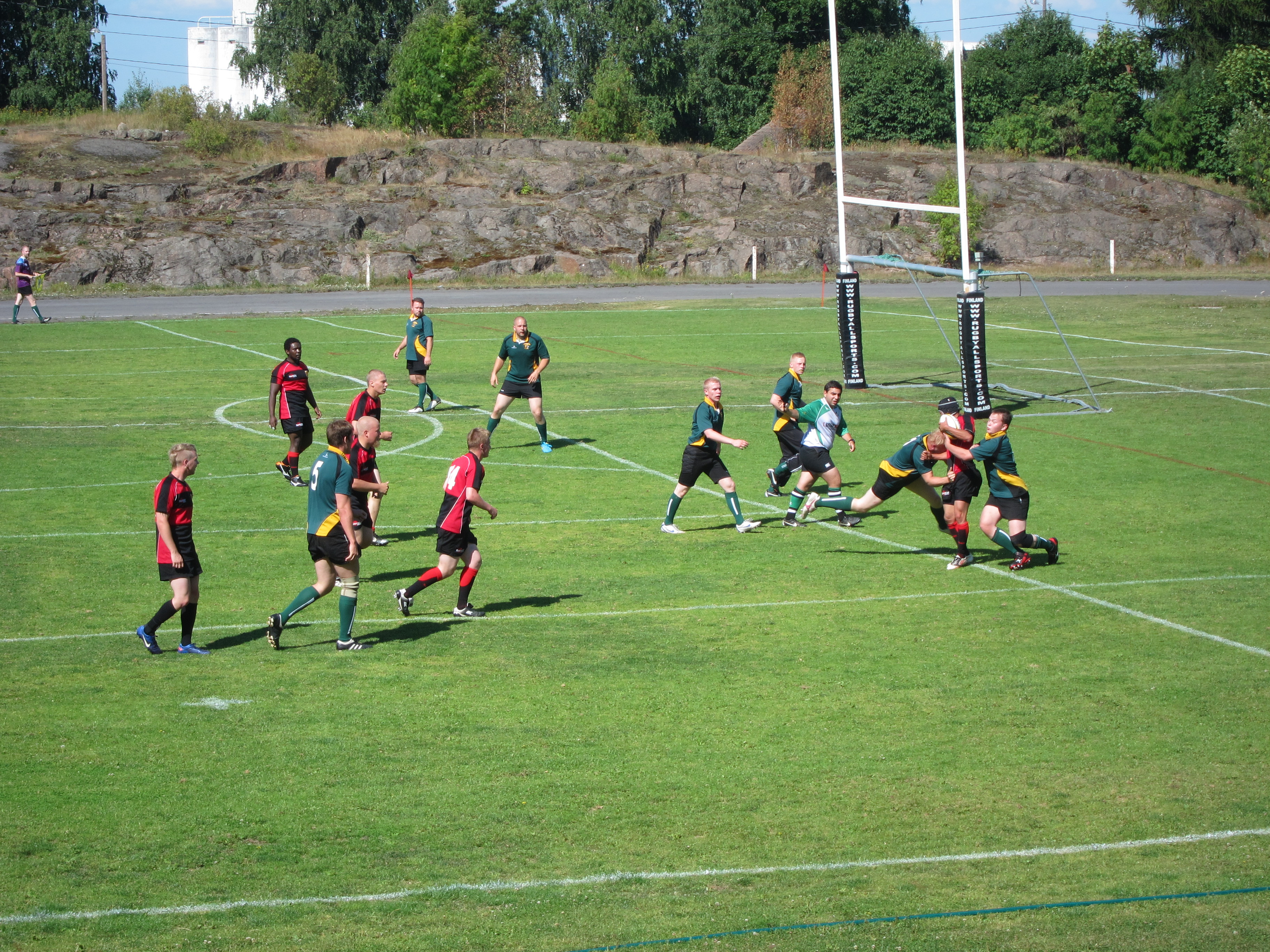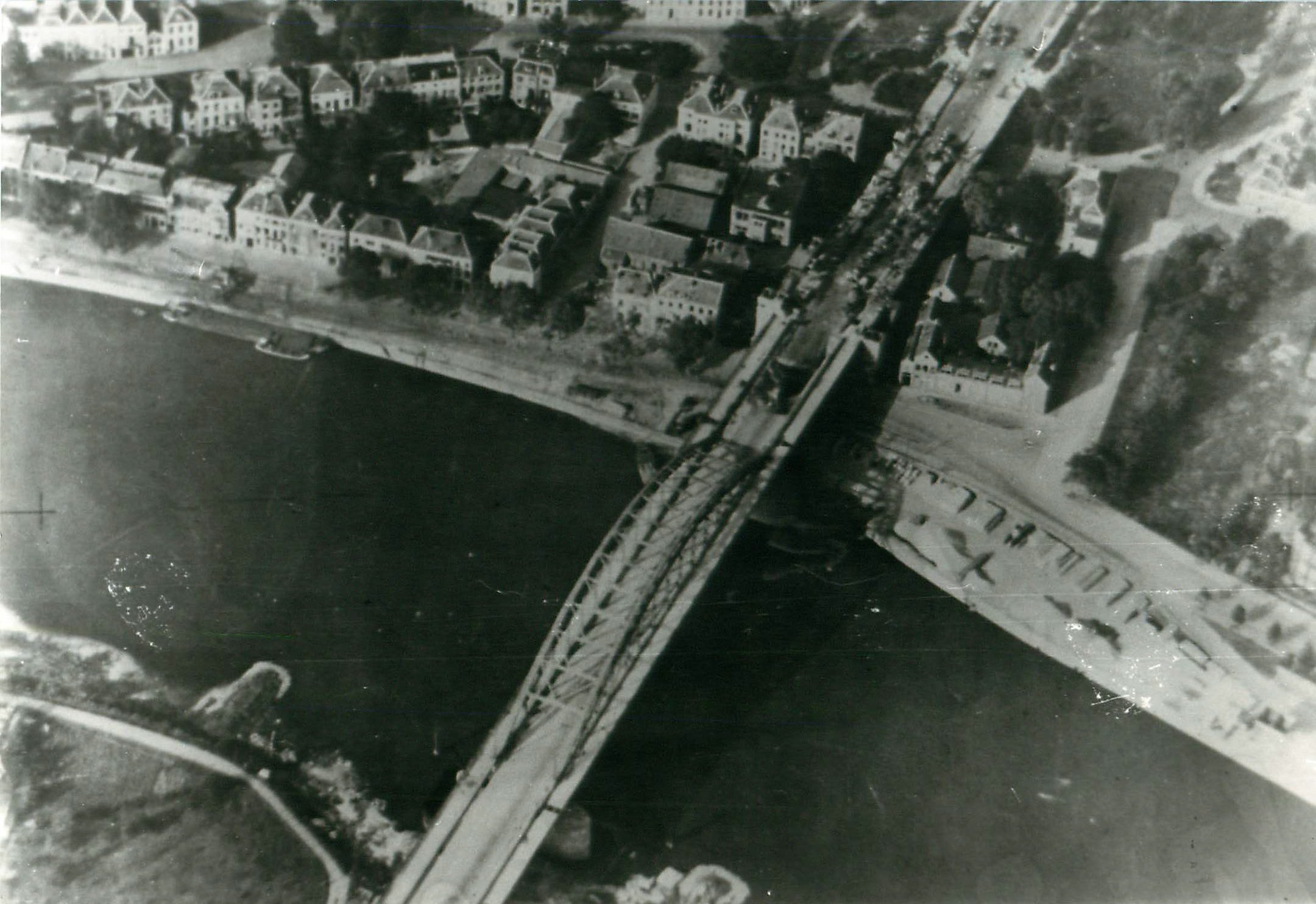|
Jack Grayburn
Captain John Hollington Grayburn VC (30 January 1918 – 20 September 1944) was an English recipient of the Victoria Cross, the highest and most prestigious award for gallantry in the face of the enemy that can be awarded to British and Commonwealth forces. Born in 1918, Grayburn was educated at Sherborne School in Dorset and joined the Army Cadet Force before the outbreak of the Second World War. He was initially commissioned into the Oxfordshire and Buckinghamshire Light Infantry and later joined the Parachute Regiment. At the age of 26 he went into action in the Battle of Arnhem where he was part of the small force that was able to reach Arnhem road bridge. Between 17 and 20 September he led his platoon, and later the remnants of a battalion, in the defence of the small British perimeter around the bridge, but was killed after standing up in full view of a German tank in order to direct his men to new positions. Grayburn is buried in the Arnhem Oosterbeek War Cemetery, a ... [...More Info...] [...Related Items...] OR: [Wikipedia] [Google] [Baidu] |
Arnhem Oosterbeek War Cemetery
The Arnhem Oosterbeek War Cemetery, more commonly known as the Airborne Cemetery, is a Commonwealth War Graves Commission cemetery in Oosterbeek, near Arnhem, the Netherlands. It was established in 1945 and is home to 1764 graves from the Second World War besides 4 later non-war graves and there are special memorials of two personnel buried elsewhere. Most of the men buried in the cemetery were Allies of WWII, Allied servicemen killed in the Battle of Arnhem, an Allied attempt to cross the Rhine in 1944, or in the Liberation of Arnhem, liberation of the city the following year. Men killed in these battles are still discovered in the surrounding area even in the 21st century, and so the number of people interred in the cemetery continues to grow. Background In September 1944 the Allies launched Operation Market Garden, an attempt by the British 2nd Army to bypass the Siegfried Line and advance into the Ruhr, Germany's industrial heartland. The operation required the I Airborne C ... [...More Info...] [...Related Items...] OR: [Wikipedia] [Google] [Baidu] |
Commonwealth Of Nations
The Commonwealth of Nations, simply referred to as the Commonwealth, is a political association of 56 member states, the vast majority of which are former territories of the British Empire. The chief institutions of the organisation are the Commonwealth Secretariat, which focuses on intergovernmental aspects, and the Commonwealth Foundation, which focuses on non-governmental relations amongst member states. Numerous organisations are associated with and operate within the Commonwealth. The Commonwealth dates back to the first half of the 20th century with the decolonisation of the British Empire through increased self-governance of its territories. It was originally created as the British Commonwealth of Nations through the Balfour Declaration at the 1926 Imperial Conference, and formalised by the United Kingdom through the Statute of Westminster in 1931. The current Commonwealth of Nations was formally constituted by the London Declaration in 1949, which modernised the comm ... [...More Info...] [...Related Items...] OR: [Wikipedia] [Google] [Baidu] |
7th (Light Infantry) Parachute Battalion
The 7th (Light Infantry) Parachute Battalion was an airborne infantry battalion of the Parachute Regiment, formed by the British Army during the Second World War. The battalion was raised in November 1942 by the conversion of the 10th Battalion, Somerset Light Infantry to parachute duties. It was initially assigned to the 3rd Parachute Brigade, part of 1st Airborne Division, but moved to the 5th Parachute Brigade, alongside the 12th and 13th Parachute battalions, of the 6th Airborne Division soon afterwards. The battalion saw combat on D-Day in Operation Tonga on 6 June 1944, the Battle of the Bulge in December and the River Rhine crossing in March 1945. After the war ended in Europe, the battalion, with the 5th Parachute Brigade, was sent to the Far East to undertake operations against the Japanese Empire. However, the war ended just after the men had started jungle training. Moving by sea, the battalion took part in the reoccupation of Malaya and Singapore. Problems in Ja ... [...More Info...] [...Related Items...] OR: [Wikipedia] [Google] [Baidu] |
Home Front
Home front is an English language term with analogues in other languages. It is commonly used to describe the full participation of the British public in World War I who suffered Zeppelin#During World War I, Zeppelin raids and endured Rationing in the United Kingdom, food rations as part of what came to be called the "Home Front". Civilians are traditionally uninvolved in combat, except when the hostilities happen to reach their residential areas. However, the expanded destructive capabilities of modern warfare posed an increased direct threat to civilian populations. With the rapid increase of military technology, the term "military effort" has changed to include the "home front" as a reflection of both a civilian "List of recognized economic sectors, sector" capacity to produce arms, as well as the structural or policy changes which deal with its vulnerability to direct attack. This continuity of "military effort" from fighting combat troops to manufacturing facilities has p ... [...More Info...] [...Related Items...] OR: [Wikipedia] [Google] [Baidu] |
Lieutenant
A lieutenant ( , ; abbreviated Lt., Lt, LT, Lieut and similar) is a commissioned officer rank in the armed forces of many nations. The meaning of lieutenant differs in different militaries (see comparative military ranks), but it is often subdivided into senior (first lieutenant) and junior (second lieutenant and even third lieutenant) ranks. In navies, it is often equivalent to the army rank of captain; it may also indicate a particular post rather than a rank. The rank is also used in fire services, emergency medical services, security services and police forces. Lieutenant may also appear as part of a title used in various other organisations with a codified command structure. It often designates someone who is " second-in-command", and as such, may precede the name of the rank directly above it. For example, a "lieutenant master" is likely to be second-in-command to the "master" in an organisation using both ranks. Political uses include lieutenant governor in various g ... [...More Info...] [...Related Items...] OR: [Wikipedia] [Google] [Baidu] |
Second Lieutenant
Second lieutenant is a junior commissioned officer military rank in many armed forces, comparable to NATO OF-1 rank. Australia The rank of second lieutenant existed in the military forces of the Australian colonies and Australian Army until 1986. In the colonial forces, which closely followed the practices of the British military, the rank of second lieutenant began to replace ranks such as ensign and cornet from 1871. New appointments to the rank of second lieutenant ceased in the regular army in 1986. Immediately prior to this change, the rank had been effectively reserved for new graduates from the Officer Cadet School, Portsea which closed in 1985. (Graduates of the Australian Defence Force Academy (ADFA) and the Royal Military College, Duntroon (RMC-D) are commissioned as lieutenants.). The rank of second lieutenant is only appointed to officers in special appointments such as training institutions, university regiments and while under probation during training. Trai ... [...More Info...] [...Related Items...] OR: [Wikipedia] [Google] [Baidu] |
Amersham And Chiltern Rugby Football Club
Amersham and Chiltern RFC are an English rugby union team located in Amersham, Buckinghamshire, England. Founded as Chiltern RFC in 1924, the club would be renamed as Amersham and Chiltern RFC in 1992. They are a member club of the Buckinghamshire Rugby Football Union. For the 2020-21 season the 1XV will play in London 1 North (RFU Level 6), the 2XV will play in Bucks Berks Oxon 1 & the 3XV will play in Herts Middlesex Merit Table 3. The club colours are claret and white. Club history Chiltern Rugby Club was formed on 20 December 1924 when a meeting was called to the house of Eric Redfern, "By The Way", Clifton Road, Chesham Bois. It was to serve the expanding unities of Amersham and Chesham. The first game was played against Berkhamsted School Old Boys XV on Boxing Day, 26 December 1924. The first home grounds were a site behind the Pineapple Public House in White Lion Road, Amersham Common together with a field in Cokes Lane until the Copperkins Lane ground was leased fr ... [...More Info...] [...Related Items...] OR: [Wikipedia] [Google] [Baidu] |
Rugby Football
Rugby football is the collective name for the team sports of rugby union and rugby league. Canadian football and, to a lesser extent, American football were once considered forms of rugby football, but are seldom now referred to as such. The governing body of Canadian football, Football Canada, was known as the Canadian Rugby Union as late as 1967, more than fifty years after the sport parted ways with rugby rules. Rugby football started about 1845 at Rugby School in Rugby, Warwickshire, England, although forms of football in which the ball was carried and tossed date to the Middle Ages (see medieval football). Rugby football spread to other Public school (United Kingdom), English public schools in the 19th century and across the British Empire as former pupils continued to play it. Rugby football split into two codes in 1895, when twenty-one clubs from the North of England left the Rugby Football Union to form the Rugby Football League, Northern Rugby Football Union (renamed ... [...More Info...] [...Related Items...] OR: [Wikipedia] [Google] [Baidu] |
Hong Kong And Shanghai Banking Corporation
The Hongkong and Shanghai Banking Corporation Limited (), commonly known as HSBC (), was the parent entity of the multinational HSBC banking group until 1991, and is now its Hong Kong-based Asia-Pacific subsidiary. The largest bank in Hong Kong, HSBC operates branches and offices throughout the Indo-Pacific region and in other countries around the world. It is also one of the three commercial banks licensed by the Hong Kong Monetary Authority to issue banknotes for the Hong Kong dollar. The Hongkong and Shanghai Bank was established in British Hong Kong in 1865 and was incorporated as The Hongkong and Shanghai Banking Corporation in 1866, and has been based in Hong Kong (although now as a subsidiary) ever since. It was "The Hongkong and Shanghai Banking Corporation Limited" in 1989. It is the founding member of the HSBC group of banks and companies, and, since 1990, is the namesake and one of the leading subsidiaries of the London-based HSBC Holdings PLC. The company's ... [...More Info...] [...Related Items...] OR: [Wikipedia] [Google] [Baidu] |
Manora Island
Manora ( sd, منهوڙو, ur, ) is a small peninsula that forms a protective barrier between Karachi Harbour to the north and the Arabian Sea to the south. Manora, having a total population of 4,273 local residents (as per 2017 census), was formerly an island, but due to silting is now connected to the mainland by a 12 kilometer long natural sandbridge known as Sandspit. The entrance to Karachi was once guarded against pirate raids by the Manora Fort built in the 1790s, which was later upgraded by the British, and then the Pakistan Navy. Geography Manora and neighboring islands form a protective barrier between Karachi Harbour to the north and the Arabian Sea to the south. The western bay of the harbor contains mangrove forests which border the Sandspit and Manora island. The coastline is also home to the ''Peelu'' tree (Salvadora persica) that protects Manora's coast from erosion. History The area of Karachi was known to the ancient Greeks. Nearchus, who commanded A ... [...More Info...] [...Related Items...] OR: [Wikipedia] [Google] [Baidu] |
Parachute Regiment And Airborne Forces Museum
The Parachute Regiment and Airborne Forces Museum is based at Duxford in Cambridgeshire and tells the story of the Parachute Regiment and other airborne forces. History The museum was established by a meeting of the Committee of the Parachute Regiment Association in October 1946. It was housed in various barracks until a permanent home at Browning Barracks at the Aldershot Garrison was opened by Field Marshal Lord Montgomery on 23 March 1969. The museum moved to a new home in partnership with Imperial War Museum Duxford under the Airborne Assault name in late 2008. The new exhibition at Duxford was opened by Charles, Prince of Wales (now King Charles III), Colonel-in-Chief of The Parachute Regiment on 8 December 2008. The exhibits New multimedia displays tell the story of today's airborne soldier and his heritage from 1940 when British Airborne Forces were first formed at the insistence of Prime Minister Winston Churchill. The displays include the original briefing models for ... [...More Info...] [...Related Items...] OR: [Wikipedia] [Google] [Baidu] |
Arnhem Road Bridge
John Frost Bridge (''John Frostbrug'' in Dutch language, Dutch) is the road bridge over the Lower Rhine at Arnhem, in the Netherlands. The bridge is named after Major-General (United Kingdom), Major-General John Dutton Frost (1912–1993), who commanded the British forces that reached and defended the bridge during the Battle of Arnhem in September 1944. The bridge was featured in the 1977 film A Bridge Too Far (film), ''A Bridge Too Far'', although the IJssel bridge in Deventer was used for the film. History Rijnbrug There had been a floating bridge at Arnhem since 1603 but as the city grew in the early 20th century a permanent link across the Lower Rhine was needed. The Rijnbrug (literally Rhine bridge) was constructed between 1932 and 1935, but was destroyed by Dutch engineers in 1940 to slow the German advance during the Battle of the Netherlands, invasion of the Netherlands. The Germans had need of the bridge however, and a pontoon bridge acted as a temporary replacement ... [...More Info...] [...Related Items...] OR: [Wikipedia] [Google] [Baidu] |







